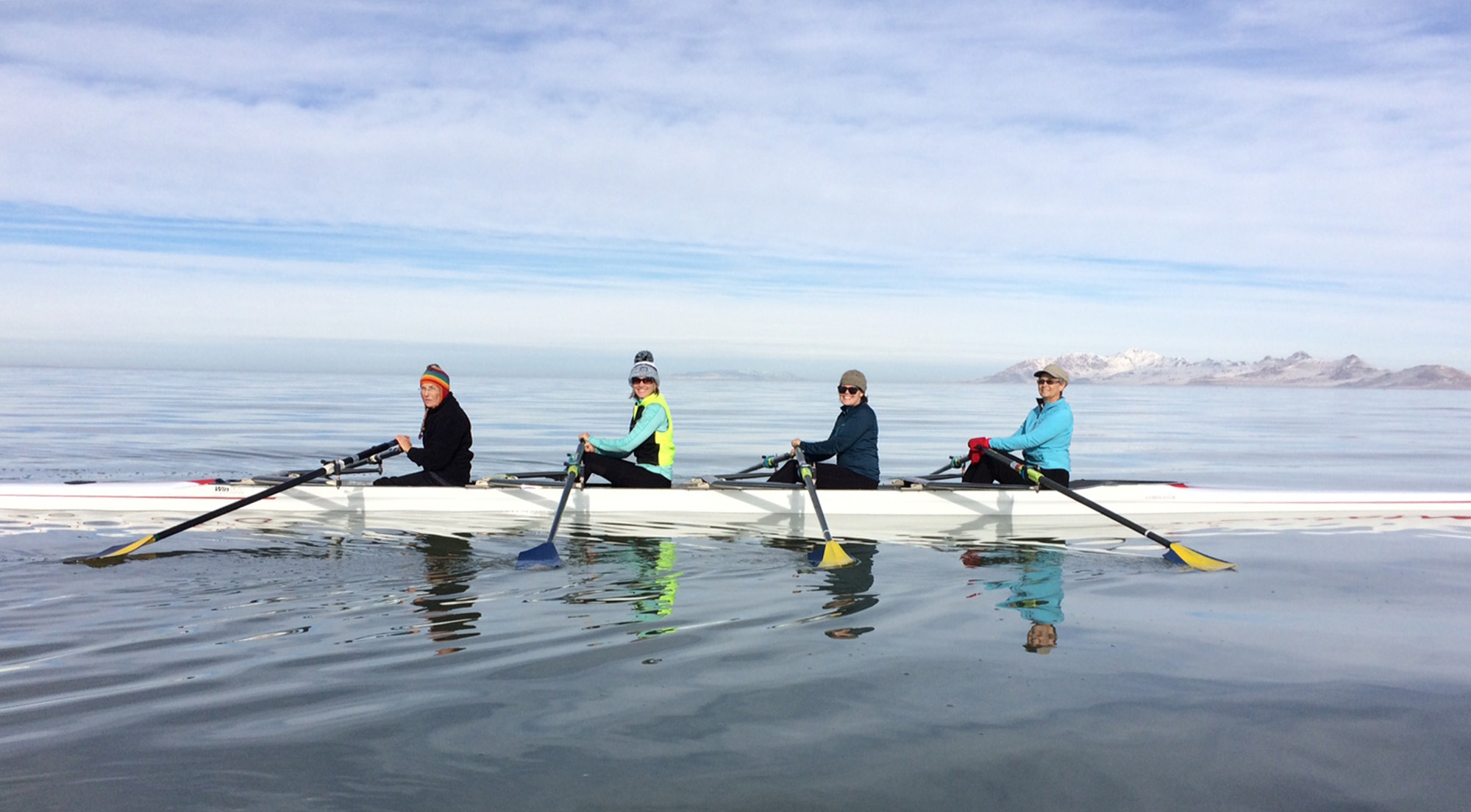Winter / Cold Weather Rowing
Rowing when the water temperature falls below 60º should be done with great consideration and caution. Hypothermia is a swift and incapacitating killer that strikes when the combination of cold weather and moisture work to decrease body temperature. It can take mere minutes before a full-size adult is incapable of helping herself/himself once hypothermia has set in. Keep in mind that you don't have to fall in the water to get hypothermia. Cold air temperatures and any moisture on the body (from being splashed, rain, sleet, snow) can lead to hypothermia.
The following measures are required by the club when working out on the water in cold weather:
1. Sign out in the logbook AND let others know when you will be on the lake. Check in when you get off the water.
2. Stay close to shore which means row along the shore toward Black Rock, or follow the red channel marker bouys towards The Great Saltair. You must be able to get yourself out of the water in under 5 minutes, and you can row in just a few feet of water. You should NOT row out toward the middle of the lake unless accompanied by a GSLR Coach in a launch. Even larger boats can capsize under the right conditions.
3. Follow the Four Oar Rule: Larger boats with four or more oars on the water are generally more stable than singles, and therefore safer to row in the cold. Club members should stick to Doubles, Quads, and Eights when the combined Air + Water temperature is below 90 degrees Fahrenheit. Even the most highly proficient rowers who have mastered the boat-flip procedure should exercise caution rowing in cold weather.
4. The Buddy System is highly recommended during winter rowing conditions when the combined Air + Water Temperature is below 90 degrees Fahrenheit. The ideal "buddy boat" is the club Safety Launch, but having 2 or more shells (with 4 or more oars each) rowing in close proximityalso meets the definition of the buddy system. The buddy system is also recommended for rowers in singles when temperatures are cool but have not yet reached a combined Air + Water temperature of below 90 degrees Fahrenheit. Non-freezing conditions can still present a hypothermia risk, so club members should try to row with another club member in 2 boats if possible (or preferably 3 boats - 1 to go for help / 1 to stay with the rower).
5. Bring a cell phone in a waterproof case or holder, this is a requirement in winter rowing conditions. A rapid response can be crucial should there be an emergency on the lake. 911 operators also have procedures for responding to emergencies at the marina or on the lake.
6. Review your boat flip procedure briefly before you row. For example: if rowing a double, make sure you and your rowing partner have a plan to get back into your boat quickly if you capsize. Also have a plan if you are not able to get back in the boat in under 60 seconds. If you struggle to get back in the boat after 1-2 attempts, return to shore and warm up ASAP. You are more important than the boat / equipment. If it's been a while since your last boat flip training, review the proper technique before going out. Flipping is somewhat uncommon in rowing, so it's good to practice even as an experienced rower!
7. Carry a noisemaker of some kind in each shell to alert fellow rowers, and be sure it is attached in some manner so as not to be lost if the shell capsizes.
8. Wear a Personal Floatation Device (PFD) / Life Vest, A compact life vest or wet suit can make a world of difference in the worst-case scenario.
The only true safety device or practice other than common sense is a support/coaching launch. In the event of an emergency, a well-prepared safety launch can assist the individuals in question and transport them to safety. Even then, hypothermia is an issue. All individuals should ask themselves before launching if being on the water is the best and only way to train.
HYPOTHERMIA
Hypothermia is a condition that occurs when the temperature of the human body is lowered to a dangerous point due to exposure to cold and/or wet conditions. Cold temperatures and wet conditions work together to pull heat away from the body, lowering the body's core temperature. Even in mild conditions, the addition of rain or submersion in cold water and can sufficiently reduce body warmth to trigger hypothermic conditions in the body. A person's condition can degrade rapidly, impairing breathing and coordination, making it impossible to swim or keep one's head above water. Emergency action needs to be taken no matter what the level of hypothermia.
EARLY HYPOTHERMIA
Symptoms: Rapid shivering, numbness, loss of strength and coordination, semi- consciousness.
Action: Maintain open airway. Transfer to a warm environment as soon as possible. Remove wet clothing. Use blankets to help warm individual or, if available, a warm shower. Warm torso area first. Seek medical attention.
PROFOUND HYPOTHERMIA
Symptoms: Person will be pale, stiff, and cold, unresponsive to stimuli, and possibly unconscious. Little or no cardiac or repository activity will be present.
Action: Move or manipulate as gently as possible. Prevent further heat loss, but DO NOT attempt to re-warm. Maintain open airway, and activate EMS procedures. Call for emergency help immediately!
Website sponsored by XMission.
Make a free website with Yola
